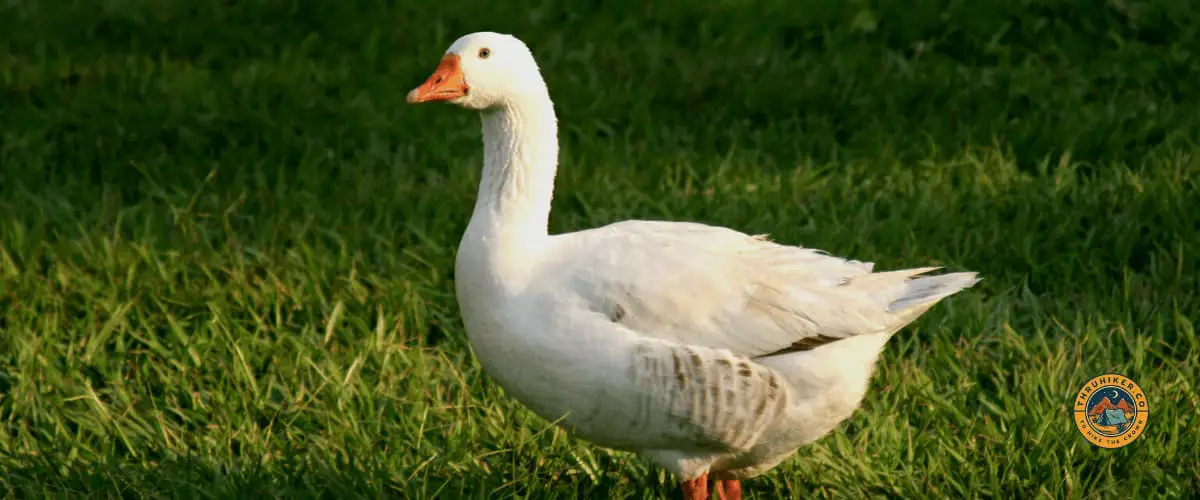Are you considering a thru-hike and getting overwhelmed trying to decide which pieces of gear you need? Are you confused when it comes to the differences between duck down and goose down?
If so, then you’ve come to the right place. In this post, I’ll break down all the key information about duck and goose down so that you can make an informed decision on what type of insulation is best for your long-distance hike.
Read on to learn more about why selecting the right type of feathery insulation matters, as well as some advantages and disadvantages associated with each option.
Nature’s Insulation: Understanding Down
Down is a type of insulating material found in many different types of birds, including ducks and geese.
It has a unique combination of qualities that make it an excellent insulator, such as its lightweight, warmth-to-weight ratio, and its ability to trap heat.
It also has a high fill power, which means it can hold a lot of air in its tiny pockets, trapping the heat inside and preventing it from escaping.
Down is also known for its softness and comfort. In fact, some people prefer it over synthetic or wool insulation because it is so comfortable.
Now that we’ve gone over the basics of down, let’s take a closer look at duck down and goose down in particular.
Duck Down vs Goose Down: Battle of the Plumes
Down is the soft under plumage (a layer of insulation underneath feathers) that geese, ducks, and other waterfowl have to keep them warm and dry.
Feathers have a hard outer shell which makes them waterproof, while down provides insulation and fluffiness.
Duck down and goose down are the two most common types used in nearly all non-synthetic insulated hiking gear.
Generally speaking, goose down is considered more luxurious, with higher quality and greater durability than duck down.
Goose down has a finer cluster than duck down, meaning it has a higher fill power and maximum fill power.
Additionally, the clusters of goose down are larger and lighter which increases its overall insulation properties.
Duck down is less expensive because it is far more common than goose down due to it being a byproduct of the meat and egg industries.
Its smaller clusters mean that the fill power is not as high as goose down, however, its insulation properties are still good.

Comparing Crucial Characteristics
Down characteristics are an important factor to consider when deciding between duck and goose down.
Down is made up of fluffy clusters of feathers that contain tiny pockets of air that trap and redistribute body heat.
The size and density of these pockets determine the insulation properties of the down:
- Goose down clusters are larger, which allows them to trap more air and provide more insulation.
- Duck down clusters are smaller and have less lift, resulting in less insulation capacity.
Additionally, goose down has a higher maximum fill power than duck down, with a maximum fill power of 1000 compared to duck’s maximum of 800.
Both types of down have great durability, with fat and oil content playing a major role in determining the life span of a product.
Goose Down vs Duck Down: Direct Comparison
When it comes to down, there are two main types: duck down and goose down.
Although duck and goose down share similar characteristics, there are a few key differences in their structure and properties.
The most notable difference is the size of the clusters.
Generally speaking, geese have larger down clusters than ducks, which results in higher fill power and better insulation.
The size of the clusters also affects the lift factor of each type of down; geese have larger clusters with higher lift, trapping and redistributing more warmth.
Additionally, goose down is usually more expensive than duck down. However, when it comes to durability, there is no major difference between goose and duck down.
Examining the Physical Properties
Physical characteristics are a major factor when choosing between goose and duck down.
Both types of down have unique characteristics that make them beneficial for different applications.
- Duck down is typically smaller, flatter, and less expensive than goose down, resulting in lower fill power.
- Goose down, on the other hand, is larger and has a higher fill power.
This higher fill power creates a greater amount of loft and insulation, making it more lightweight and better for packability.
Additionally, the higher quality of goose down also means it is more resilient than duck down and can last much longer with proper care.
Warmth-to-Weight: The Hiker’s Holy Grail
When it comes to the warmth-to-weight ratio, goose down has the advantage as it is loftier than duck down, has a higher fill power, and can trap more air.
This higher fill power means it provides more warmth for its weight, making it a great choice for those who want lightweight but warm insulation.
Duck down is still a great option for insulation, but its lower fill power means that it doesn’t provide quite as much warmth for its weight.
Cluster Power: Loft and Insulation Efficiency
The next important factor to consider when looking at the difference between duck and goose down is the size of the clusters.
Goose down clusters are typically larger than duck clusters, often coming from larger, older animals.
This means that goose down has larger loft, meaning it can trap more air in its clusters and provides more insulation.
The larger clusters also make the goose down more durable than duck down, so it can withstand more wear and tear over time.
Additionally, because of its larger size, goose down is generally more expensive than duck down.
Temperature Control: Which Down Keeps You Warmer?
When it comes to insulation, it’s important to consider fill power and warmth-to-weight ratio.
Fill power measures the quality of down—the higher the fill power, the better the insulating quality.
Duck down and goose down have similar fill powers when considering the same temperature rating.
However, goose down tends to be loftier, meaning it has more air pockets which provide better insulation.
This means that for a given fill power, goose down is usually considered warmer than duck down.
Duck Down Deep Dive
Duck down insulation is lightweight, resilient, and has high lofting power. Its thermal insulation is slightly lower than goose down, but it is still an excellent insulating material.
It’s also more affordable than goose down, making it an ideal choice for those who are looking for a budget-friendly solution.
The main difference between duck and goose down insulation is the size and fill power of the clusters.
Duck down has smaller clusters with a lower fill power, meaning it can’t trap air as efficiently as goose down and therefore is not as warm.
However, it still provides superior insulation compared to synthetic alternatives like polyester fibers.
Goose Down Decoded
Goose down is generally higher in fill power than duck down, boasting a maximum fill power of 1000, depending on the quality.
It is also known for being softer, warmer, lighter weight, and more compressible than duck down. It is also more resilient and has good insulating properties due to its larger clusters.
Furthermore, goose down is the only type of down that can be used for ‘soft’ applications such as pillows and duvets.
However, when it comes to insulation properties, a 550-fill power duck down is equal to a 550-fill power goose down in resilience and ability to insulate.

Head-to-Head: Duck and Goose Down Face Off
When it comes to insulation properties, both duck and goose down are very similar.
The insulation values of both are measured using the same standard technique, and the high fill power of both provides excellent insulation.
However, goose down has larger clusters than duck down, giving it a higher fill power which provides better insulation and a fluffier feel.
While there is no major difference in the durability of both types of down, goose down does have a higher warmth-to-weight ratio than duck down.
Therefore, for optimal warmth and comfort, goose down is often considered the best choice.
The Price of Warmth
The price difference between duck and goose down can be quite substantial. Generally, goose down is more expensive than duck down due to its better insulation properties.
The price of goose down is higher because it is in higher demand due to its superior quality.
Duck down, on the other hand, is more affordable and is often used in lower-end budget products such as sleeping bags, backpacking quilts, and puffy jackets.
The cost of duck down will vary depending on the quality of down used, while the cost of goose down will remain fairly steady.
Balancing Cost and Performance in Down Selection
When it comes to the cost of duck and goose down, the price of goose down has soared over the past few years.
This is mainly due to the insulating power and packability of goose down, which is found incredibly valuable in hobbies like backpacking where space and weight are a huge concern.
Goose down also has a higher fill power, which means it produces more warmth for less down weight. However, duck down is more widely available and is usually less expensive than goose down.
The durability of both types of down is comparable, and neither has a significant environmental impact.
Longevity on the Trail: Durability Face-Off
When it comes to durability, both goose and duck down are generally quite durable. However, part of how durable they are depends on the down’s fat and oil content.
Inherently, there is a higher content of oil and fat in some goose down than in duck down, which could make the difference in terms of durability.
This varies from one batch to another, so it is important to check the product specifications before making a purchase.
In addition, goose typically has a slightly higher fill power than duck, making it slightly more resilient to compression over time.


Leave a Comment